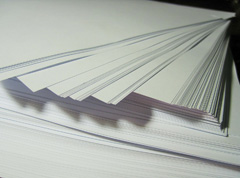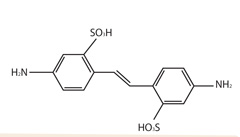|
When measuring brightness, a light source is directed at the paper in question, and the amount of blue light reflected off the surface is recorded. The wavelength for blue light is 457 nanometers. The type of light source varies depending on the testing method used. These methods are discussed in the next section.
Brightness measurements were first developed to test the results of bleaching wood pulp. The bleach removes the natural yellowish tint of the natural pulp, and the test would be able to determine the change before and after the process. Today, most papers - at least for printing - are bleached to some extent.
The measurement is based on the percentage of light reflected back, based on a scale between 1 and 100%. The higher the percentage, the more blue light reflected by the paper, and the brighter it appears.
Just because two different papers have the same brightness rating, however, does not mean they will appear the same color to the human eye. Since only one wavelength (color) of light is measured, brightness does not account for the amount of other wavelengths reflected off a paper. Two papers could reflect 87% of the blue wavelength, while one reflects 50% and the other reflects 80% of the red wavelength.
OBAs
In general, white papers have a brightness of between 60 and 90%. However, added optical brightening agents (OBAs) can raise this number considerably. This is why you may have come across a paper with a brightness above 100. This is not possible in a natural situation, where the paper is constructed solely of wood pulp.
Once brighteners are added, however, UV light is reflected in addition to the other wavelengths. The UV light going to the paper is not visible to the human eye, but the brighteners transform it into visible light. Therefore, more visible light is reflected off the paper than was absorbed onto it, making it appear brighter.
Since brightening agents haven't been around for too long, their stability and archival reliability is still uncertain. It is known they may fade over time, diminishing the perceived brightness of the paper.
In addition to the percentage rating, brightness may also be identified by a name such as Ultra Bright or Very Bright. These "ratings" are not standardized, however, and should not be used to compare papers.
|

Brightness is a paper specification

Diamino Stilbenedisulfonic acid, a popular OBA
|

